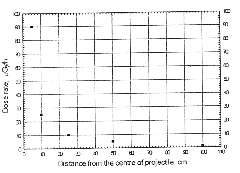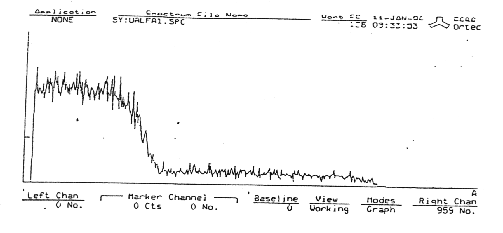
Figure 1. Picture of the projectile
D. Ristic, R. Benderic and Z. Vejnovic - Institute of Security, Belgrade
M. Orlic and S. Pavlovic - Institute of Nuclear Sciences "Vinca", Belgrade
During the bombing of military and civilian targets in the Serbian Republic, NATO forces have used special ammunition produced from depleted uranium. Beside its great piercing power, it also presented a certain radioactive hazard for the armed forces, the civilian inhabitants and the environment as a whole.
Depleted uranium is a radioactive nuclear waste. Its radioactivity comes from the decay of uranium-238, uranium-235 and other daughters. Measured and estimated activity of the round is about 3,4 MBq. Total emission of alpha and beta particles from the round surface is 1.198 alpha, i.e. 35.914 beta particles per second. In contact with the rounds, because of the presence of radioactive radiation, skin changes may occur (necrosis and ulceration) which can be visibly manifested in something less than 80 hours.
In this paper mechanical, physical and chemical characteristics of this ammunition as well as the results of domestic and spectrometric measurements and dose and affects estimate are given.
NATO forces have vastly used the ammunition produced out of depleted uranium. Ammunition produced out of this uranium presents a radioactive waste of the process of production of enriched uranium. The projectiles are made of an aluminum shell of 86 mm length and 30 mm radius. Inside the shell is a gray cylindrical armor-piercing round, which leaves the aluminum shell upon stroking against an obstacle on its way to the target. The radius of the cylindrical part of the core (round) is 16 mm, while its length is 96 mm. The top part of the round has a conic shape (Figure 1). Round's mass is 292.18g, its evaluated density 18.41 g/cm3.

Visual evaluation, measuring and studying of characteristic sizes and characteristics established it to be ammunition of 30 mm caliber, API PGU -- 14/B propelled from the seven-barreled cannon GAU 8/A type GELTING, with which aircraft A-10, stationed at aircraft carriers, are armed. /1,2/
The hardness of the projectile core is 48 and 49 HR measured by the ROCKWELL method (DIATESTOR 38106 HRo/HRb). Its hardness according to BRINELL is 470 HRb while the X-ray-fluorescent spectrometer PHILLIPS, model PW 1480. The samples were treated with radiation with a continuous specter of the X-ray tube, with Rh anode of "side window" construction, in vacuum. Two analitical-dispersive crystals of type PET (2d=8,742A; hkl=oo2) and LIF (2d=2,848 A; hkl = 220) enabled recording of light and medium-weight, as well as large-weight elements /5/.
Recording and identification of the chemical elements spectral lines has been made with the support of the appropriate PHILLIPS PC computer and the software package PW 1492.
The analysis of the projectile cores (Figure 2) identified the predominant presence of uranium (U) and in relatively small concentration also iron (Fe), titan (Ti), nickel (Ni), zinc (Zn), copper (Cu) and circonium (Zr).

Based on the data obtained through a physical-chemical and mechanical analysis, it can be concluded that the projectile cores are made of the alloy that contains a high percentage of uranium.
Through measuring with the X-ray radiation detector BERTHOLD D7547 Wildbad, RATD/F on the spot (on the ground), the presence of radioactive radiation was established. The strength of the gamma radiation dose in the air was about 0.1 µGy/h, which made us suspect the presence of a radioactive material. Therefore, dosimetric measuring and spectrometric analysis of radioactive radiation were done.

The dependence of the strength of the gamma radiation dose on the distance, measured with the BABYLINE 31 SYSTEM CEA, TYPE 433, Nardeux-Loches, is shown in Figure 3.
Gamma-spectrometric analysis was done with the gamma spectrometer of type "ADCAM MCA-350" ORTEC with HP Ge detector of high resolution (1,85 keV for energies of 1,33 MeV) and detection efficiency 28.1% (Figure 4).

Measuring of alpha radiation was done with "ALFA-SPECTROMETER-576 A" - ORTEC, of resolution 18 keV for energies of 5.4 MeV (Figure 5).

Measuring of low alpha and beta activities was made with the counting system TENNELEC LB 51 00. For measuring we used the flow proportional counter of counting efficiency 53,4% for Sr-90 and 43,9% for Po-210, of 80ug/cm2 window diameter.
Through gamma spectrometric measuring a large number of characteristic peaks was established. The analysis of the obtained peaks clearly points that are the consequence of the decay of uranium-238 and uranium-235, and their descendants. Their analysis with the correction of self-absorption established the activity of alpha radiation measured on an alpha spectrometer with semiconductor Si-Li detector and flew proportional counter are in accordance.
The greatest contribution to the strength of the dose is given by the gamma radiation of mean energy of about 48 keV. It is equivalent to the gamma constant of 0.071 (R cm2)/ (h Bq). The dose of radiation treatment with gamma rays can derive only from the external low-energetic gamma radiation. The estimate of the worst case relates only to the person in direct contact with the sample. If we presume that effective distance from the critical organ is 50 cm, then the strength of the dose on that distance is about 5 µGy/h. That means that in 400 hours a dose of 2 mGy would be accumulated (which corresponds to the equivalent dose of 2 mSv), i.e. to the dose that an individual average receives from natural sources of radiation. The dose of 5 mSv (annual dose for inhabitants) will be received in 1000 hours, and dose of 50 mSv (annual dose for professionals) in 5000 hours (about 200 days) /8,9/.
The strength of the absorbed alpha radiation dose on skin surface (physical contact) is 0.50 Sv/h.cm2. As it is well-known, changes on the skin appear with the equivalent dose of 40 Sv. If the skin is in contact with the round changes in it will appear in about 80 hours. The number of alpha particles emitted from the total surface of the round is 1198, which means that changes could appear even much earlier /8,9/.
The strength of the absorbed dose of beta radiation in contact with the skin is about 1,4 mSv/h.cm2. Changes on skin caused by beta radiation will be manifested in about 28.500 hours. The number of beta particles emitted from the total surface of the round is 35.914 per second, which means that changes on the skin could appear much earlier. /8/.
During bombing of inhabited places in the Serbian Republic, NATO forces have used special ammunition of 30 mm caliber, made out of the depleted uranium. Depleted uranium is a radioactive nuclear waste. Its radioactivity comes from the decay of uranium-238, uranium-235 and their descendants. Measured and estimated activity of the round is about 3,4 MBq. Total emission of alpha and beta particles from the round surface is 1.198 alpha i.e., 35.914 beta particles per second. In contact with the rounds, because of the presence of radioactive radiation, skin changes may occur (necrosis and ulceration) which can be visibly manifested in something less than 80 hours.
According to our regulations and the International standards, uranium belongs to the group of toxic elements and is classified in the II group of radionucleids of very high radio toxicity.
This type of ammunition presents, besides other things, a form of radioactive arms whose use cannot be justified with anything and its application is in essence a crime against humanity and the international law.
Therefore a protest should be put forward to the United Nations, the OEBS, to European Union, International Agency for Atomic Energy, and to other international political and humanitarian organizations.
/1/ Haye, C.L. Rios F.G. and Thoront, J.I. "Density Characterization of Armor Piercing Ammunition," Journal of Forensic Sciences, JFFFFSCA, Vol. 40, No.3 pp. 401-405, May 1995
/2/ SATORYX, TOME 1. Paris 1985
/3/ JUS ISO 6580, 1994, Mehancka ispitivanja metala, Ispitivanje tvrdoce po Rokvelu (Skala A-B-C-D-E-F-G-H-K) "Mechanical examinations of metals, Examination of the hardness according to Rockwell - Scale A-B-C-D-E-F-G-H-K".
/4/ JUS C.A.U. 032, 1986, Mehanicka ispitivanja materijala, Izracunate vrednosti tvrdoce po Brinelu ; "Calculated values of hardness according to Brinell"
/5/ Benderac R. Primena rendgenfluorescentne analize u sluzbi bezbednosti, HTI-38, Institut bezbednosti, 198; "Application of X-ray-fluorescent analysis in the security services," HTI-38 Institute of Security, 1988
/6/ Erdtmann, G. Sovka, W. "The Gamma Rays of the Radionucleids, Topical presentations in Nuclear Chemistry,"
Vol. 7 1979
/7/ "Radionucleide transformation, Energy and Industry of Emissions, ICRP Publication 38, Volumes 11-13, Pergamon Press, 1983
/8/ Profio A. E. "Radiation Shielding and Dosimetry," John Wiley & Sons, New York 1979
/9/ ICRP Publication 30. "Limits for Intakes of Radionucleids by Workers," Annals of the ICRP, Editor Sowby, F.D. Persimmon Press 1982.